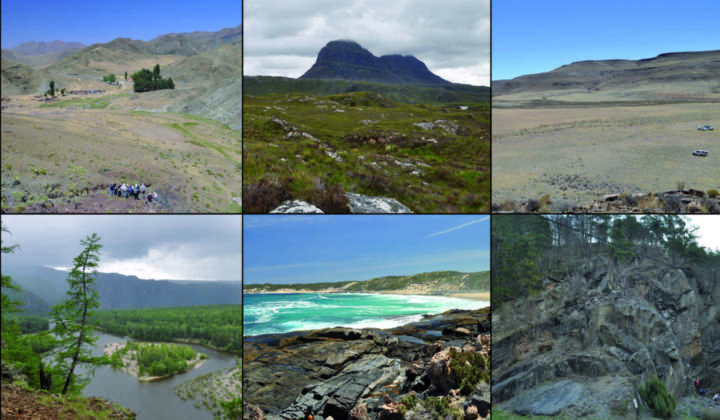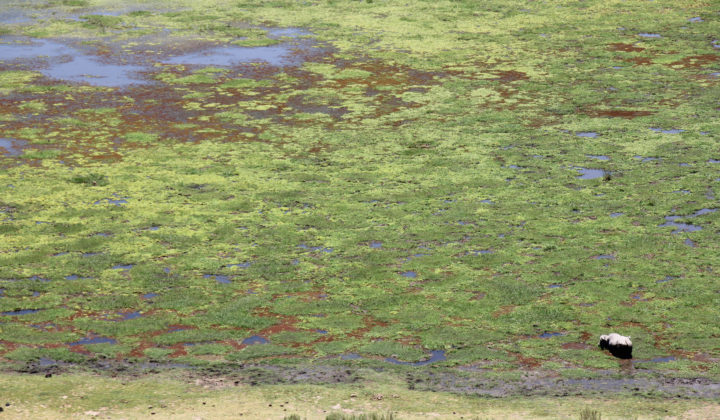
Climatic cyclicity and biodiversity during the Quaternary
The evolution of our planet was marked several times by the effect of global ice ages. From about 15 million years ago a trend of global cooling is noted, which culminated in spectacular glacial periods of the Quaternary.
Large-scale fluctuations in global climate and resulting environmental changes had a profound effect on the origin of species, on the development of their subsistence strategies and the resulting formation and dispersal of faunal assemblages. Current research is investigating the relationships between rhythmic climate variability and regional to transregional biodiversity during the Quaternary in Eurasia. Of particular interest is the influence of duration and intensity of climatic cycles on faunal evolution. Moreover, it appears possible to derive factors stimulating the spread of early humans in Europe.
Academic cooperation partners
N. García (University Complutense, Madrid), S. Gaudzinski (University of Cologne, Römisch-Germanisches Zentralmuseum Mayence), H. Hemmer (University of Mayence), C. Hertler (ROCEEH, Frankfurt/M.), T. Kaiser (University of Hamburg), D. S. Kostopoulos (University of Thessaloniki), F. Lacombat (Museé Crozatier, Le Puy-en-Velay), A. M. Lister (Natural History Museum, London), D. Lordkipanidze (Georgian State Museum, Tbilisi), P. P. A. Mazza (University of Florence), N. Spassov (National Museum of Natural History, Sofia), V. V. Titov (Russian Academy of Sciences, Rostov-on-Don), and curators and participants in corresponding excavation projects, if possible.
The Epivillafranchian of Untermassfeld – Interdisciplinary analysis of a key Eurasian fauna
The period between 1.2 and 0.9 Myr BP was characterised by increased climatic variability and corresponding faunal changes on the entire northern hemisphere. For the western Palaearctic a distinct biochron, the Epivillafranchian, was defined. However, extended large mammal records from this period remained rare in Europe.
Approximately 1.05 million years ago in Southern Thuringia (Central Germany) a fossil carcass-field was formed due to a catastrophic impact of high flood events of the river Werra, which led to the deposition of body remains of hundreds of mammals. Senckenberg excavation teams recovered fossil vertebrate material, which is unique in Western Eurasia in terms of diversity, quality and quantity. The meanwhile 15,000 conserved and documented finds enables for the first time detailed insights into the fauna of Europe one million years ago – a time of vital decisions for the survival of many animal groups during the Quaternary.
The finds and data were studied by an extended international/interdisciplinary work group coordinated by Ralf-Dietrich Kahlke (state of 29.4.2022):
| 1.) | Excavation and documentation | Teams of Senckenberg Research Station of Quaternary Palaeontology Weimar |
| 2.) | Regional and local research history | R.-D. Kahlke (Weimar) |
| 3.) | Regional geology and sedimentology | J. Ellenberg (Jena) |
| 4.) | Geological structure of the site | R.-D. Kahlke (Weimar) |
| 5.) | Geological history of the site | A. Gärtner (Dresden) and R.-D. Kahlke (Weimar) and U. Linnemann (Dresden) |
| 6.) | U-Pb datation of redeposited travertin | A. Gerdes (Frankfurt/M.) and R.-D. Kahlke (Weimar) and A. Gärtner (Dresden) and U. Linnemann (Dresden) |
| 7.) | ESR/U-series dating | C. Falguères (Paris) and J.-J. Bahain (Paris) |
| 8.) | Amino acid racemization dating | K. Penkman (York) |
| 9.) | Palynology | M. Stebich (Weimar) |
| 10.) | Macrobotany | F. Kienast (Weimar) |
| 11.) | Gastropods | E. Krolopp † (Budapest) |
| 12.) | Ostracods | E. Pietrzeniuk † (Berlin) |
| 13.) | Fishes | E. Rutte † (Würzburg), M. Böhme (Tübingen) |
| 14.) | Amphibians | G. Böhme (Berlin), M. Böhme (Tübingen) |
| 15.) | Reptiles | M. Böhme (Tübingen) |
| 16.) | Birds | D. Jánossy † (Budapest), A. Manegold (Karlsruhe) |
| 17.) | Bovids | A. Sher † (Moscow), M. Bukhsianidze (Tbilisi) |
| 18.) | Cervids | H.-D. Kahlke † (Weimar), M. Breda (Ferrara) and A. Lister (London) and R.-D. Kahlke (Weimar) |
| 19.) | Hippopotamids | R.-D. Kahlke (Weimar) |
| 20.) | Suids | C. Guérin † (Lyon) and M. Faure (Lyon), A. Iannucci (Rome) |
| 21.) | Rhinocerotids | H.-D. Kahlke † (Weimar), A. Kotowski (Wrocław) and K. Stefaniak (Wrocław) and R.-D. Kahlke (Weimar) |
| 22.) | Equids | R. Musil (Brno), V. Eisenmann (Paris) and N. Boulbes (Paris) |
| 23.) | Elephantids | I. A. Dubrovo (Moscow), H. van Essen (Dieren), D. Mol (Rotterdam) |
| 24.) | Canids | M. V. Sotnikova (Moscow) |
| 25.) | Ursids | R. Musil (Brno), N. Garcia (Madrid), P. P. A. Mazza (Florence) |
| 26.) | Mustelids | M. Wolsan (Warsaw) |
| 27.) | Hyaenids | A. Turner † (Liverpool), A. Iannucci (Rome) and B. Mecozzi (Rome) and R.-D. Kahlke (Weimar) and R. Sardella (Rome) |
| 28.) | Coprolites | J.-A. Keiler (Weimar) |
| 29.) | Felids | H. Hemmer (Mainz) and R.-D. Kahlke (Weimar) |
| 30.) | Insectivores, lagomorphs and rodents | L. C. Maul (Weimar) |
| 31.) | Cercophitecids | H. Zapfe † (Vienna), J. W. F. Reumer (Rotterdam) and R.-D. Kahlke (Weimar) |
| 32.) | Taphonomy | R.-D. Kahlke (Weimar) and S. Gaudzinski (Neuwied) |
| 33.) | Bone surface modification | L. Steguweit (Erlangen) |
| 34.) | Bone surface modification by insects | J.-A. Keiler (Weimar) and M. Benecke (Cologne) and J. Keiler (Rostock) |
| 35.) | Bone surface modification by hyenas | J. Arnold (Jena) |
| 36.) | Tooth root cementum analysis | H. Kierdorf (Köln), N. García (Madrid) |
| 37.) | Mesowear analysis | E. N. van Asperen (Liverpool) and R.-D. Kahlke (Weimar) |
| 38.) | Herbivore osteophagia | R.-D. Kahlke (Weimar) |
| 39.) | Rodent gnaw marks | L. C. Maul (Weimar) |
| 40.) | Palaeopathology | U. Kierdorf (Hildesheim) and S. Flohr (Hildesheim) and R.-D. Kahlke (Weimar) |
| 41.) | Palaeotemperature determination | E. Stephan (Tübingen) and H.-P. Uerpmann (Tübingen) and B. Cramer (Tübingen) |
| 42.) | Analysis of stable isotopes | N. García (Madrid) and R. S. Feranec (Berkeley) and R.-D. Kahlke (Weimar) |
| 43.) | Palaeoecology | R.-D. Kahlke (Weimar) |
| 44.) | Stratigraphy | R.-D. Kahlke (Weimar) |
| 45.) | Methods of bone preparation and conservation | J.-A. Keiler (Weimar) |
Origin, disperal and improverishment of Eurasian
cold adapted faunas
Climatic change and orogenetic processes during the late Tertiary and Quaternary led to a drop of temperatures and humidity in Eurasia’s northern and moderate latitudes. From around 500,000 yr BP, during the Middle and Late Pleistocene cold stages, the so called Mammoth Faunas (Mammuthus-Coelodonta Faunal Complex) evolved. These faunas ranked as the most effective cold-adapted mammal associations in the history of the earth.
The Eurasian cold period faunas are mostly drawn from descendents of northern tundra as well as central Asian steppe inhabitants. Studies of distribution of the fossil finds of key members of this fauna show how their geographical distributions responded to Middle and Late Pleistocene environmental changes. Moreover, the biodiversity and biogeography of the various evolutionary stages of the Pleistocene cold adapted faunas are analysed.
Academic cooperation partners
D. J. Álvarez-Lao (University of Oviedo), B. Buigues (Cerpolex, Paris), N. García (University Complutense, Madrid), F. Lacombat (Musée Crozatier, Le Puy-en Velay), D. Mol (Cerpolex/Mammuthus, Amsterdam / Natuurmuseum, Rotterdam), H. v. d. Plicht (University of Groningen), J. W. F. Reumer (Natuurmuseum, Rotterdam), A. Tikhonov (Zoological Institute of the Russian Academy of Sciences, St. Petersburg)


